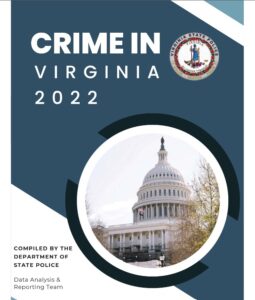 by Dick Hall-Sizemore
by Dick Hall-Sizemore
I like to do what I call “poking around the numbers.” Breaking down datasets for large entities, such as statewide data, can yield enlightening, and sometimes surprising, results.
I was intrigued by the Virginia State Police report of officer-involved shootings that Jim Bacon reported on earlier. The big increase from 2021 to 2022 led to all sorts of speculation as to its causes. I thought it might help to break down the incidents by jurisdiction.
The 2016 General Assembly enacted legislation requiring the State Police to include officer-involved shootings in its annual Crime in Virginia report. The 2017 report was the first time such data were reported. Consequently, there have been six years of reports.
For some incidents, there was more than one law-enforcement agency involved. In such circumstances, I counted both agencies. For those involving the State Police, I attributed the involvement to the State Police, rather than the jurisdiction in which it occurred.
Over the course of the seven years, law-enforcement officers from 77 political subdivisions and state agencies were involved in shootings at least one time. In addition to counties and cities, law-enforcement officers from the following were involved;
- Towns–8 (Blacksburg, Grundy, Herndon, Luray, Rural Retreat, South Hill, Timberville, and Woodstock)
- State agencies—2 (State Police and Dept. of Wildlife Resources)
- University police—1 (Christopher Newport University)
There was no geographic pattern. Officers were involved in shootings from Grundy in the Southwest to Virginia Beach in the southeastern part of the state to Alexandria in Northern Virginia and multiple points in between.
During the seven years, officers from the Virginia State Police were involved in the most shooting incidents, 19. Only officers from two localities were in double digits — Richmond (12) and Norfolk (11). Only the State Police had officers involved in shootings in each of the seven years. Only four localities—Henrico, Prince William, Richmond, and Virginia Beach — had officers involved in six of the seven years.
The significant increase in officer-involved shootings from 2021 to 2022 has fueled some speculation, on which the data resulting from my poking around may shed some light. Jim Bacon suggested that the increase in officer-involved shootings was related to the increase in killings and assaults on officers. Unfortunately, the State Police does not provide sufficient detail on the officers killed and assaulted to test that theory. Jim goes on to hypothesize that “the common thread has been media- and politician-fueled rhetoric that has fed the perception among those inclined to criminal conduct that policing, the criminal-justice system, and society in general are systemically racist and illegitimate.” Finally, he speculates on whether the increase occurred primarily in African-American communities. The breakdown in the 2022 data relates to these two issues, at least indirectly.
With the data available, the best way to address these questions is to determine which localities were “driving” the increase. Comparing the number of officer-involved shootings in 2021 with the number in 2022, the following localities contributed a net increase of 17:
- Arlington—1
- Fairfax County—4
- Henrico—1
- Norfolk—4
- Portsmouth—3
- Prince William—1
- Richmond—2
- Virginia Beach–1
Several of those localities have large African-American communities and have been accused of pushing rhetoric and practices that call into question the legitimacy of the criminal justice system.
However, largely offsetting those net increases were net increases of 15 from the following localities that do not fit that description:
- Alleghany—2
- Amherst—1
- Blacksburg—1
- Buena Vista—1
- Covington—1
- Dickenson—1
- Floyd—1
- Grundy—1
- Henry—1
- Louisa—1
- Lynchburg—1
- Orange—1
- Shenandoah—1
- Woodstock—1
These localities are in rural areas that generally support law enforcement and do not have large African American communities.
Based on this data, one would have to say that the explanations for the increase advanced by conservatives on this blog are not supported by the evidence. Something else was going on.


